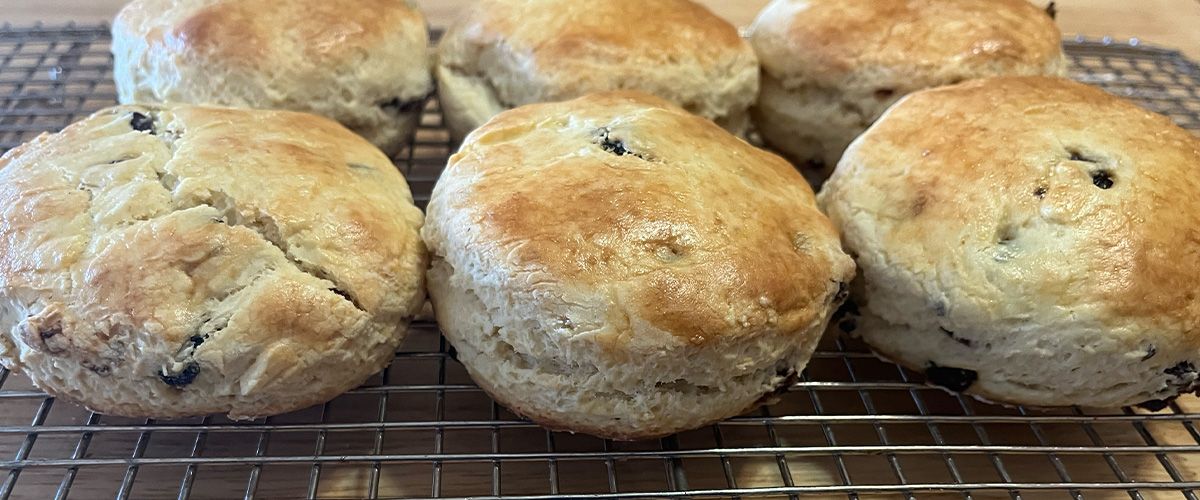Traditional English Scones

A few years ago I made a goal of 'mastering' scones. Today, I am still working on it.
What Led to My Scone Goal
Let's take a quick step back. I got introduced to the Great British Bake-Off (GBBO), known as the Great British Baking Show here in the U.S., several years back by a friend, right around season 4 I believe. It is hard to say exactly when since I was watching it on PBS sometime after their original airing. I was fascinated by what the home bakers were doing. Then I started hearing about scones. I tried to make them and they didn't turn out quite right, so I tried again. Then I started researching different scone recipes. You get the picture I think. That became the jumping off point for more baking. I took a croissant making class at the local kitchen goods store, Sur la Table. I picked a baking book (why are they called cookbooks if they are all about baking?) on baking bread. And so on. Through all of that though, I still have been working on mastering scones.
What Prompted this Test Round
Fast forward to today. I have been attending Bake from Scratch Baking School virtually through Williams-Sonoma (this is my third round of 10 sessions) and our class on February 19th is (American) Biscuits* vs. Scones with Edd Kimber, the first winner of GBBO. Ok, first I was thrilled about the whole scone part (oh and I love all kinds of biscuits as well). And second, who was Edd Kimber? Remember, I didn't start with GBBO until around season 4.
Lucky for me, my Roku has the old, pre-channel 4 (GBBO fans know what I mean) episodes, including the very first GBBO where Edd Kimber was the very first winner. It was different from what we see today. They moved around to different locations and interspersed the baking with baking history (so cool).
How Did This Recipe Compare to the Others Tried
Anyway, so when I received this week's lesson, I headed to my kitchen to try my hand at a Traditional English Scone. There are several differences from the scone recipes that I have tried to date.
- Plain Flour is used vs All-Purpose Flour or Self-Rising Flour
- Less Butter
- More Sugar
- Hydrated dried fruit
- Eggs in the batter not just an egg wash
- One hour rest time
The Traditional English Scone recipe calls for Plain Flour. This is not something in the U.S. we often see. Several English recipes list that cake flour can be used instead of plain flour. You can also use all-purpose flour, the texture may be a little different but still delicious. For the scone recipes that I've tried in the past, either All-Purpose Flour or Self-Rising Flour was called for. I remember great-grandma using cake flour for some of the best cakes, but not for biscuits. If you don't have cake flour, you can make your own with all-purpose flour and cornstarch. For American Biscuits, typically Self-Rising Flour is used. If you don't have self-rising you can make your own with all-purpose flour, baking powder and salt. Because the self-rising flour has a rising agent, baking powder, you most likely won't need to add another.
My go-to basic scone recipe has 113 g of unsalted butter, twice the amount of what I tried this go round.
There is 100 grams of castor sugar in this recipe. I typically only have about 43 - 50 g of granulated sugar. Castor sugar is a superfine sugar. I used King Arthur Baking Baker's Special Sugar, their castor sugar since I had some on hand for other recipes. If you don't have castor sugar and you have a coffee or mini grinder, put the amount of sugar you need in the grinder and give it a few quick pulses.
There recipe also calls from raisins or sultanas. I have raisins but not sultanas and this is not the first time I have added them. This is the first time though, soaking them in hot water before using. I like the result and will definitely do it again.
Other than an egg wash to get that golden brown color, the recipes I've have used didn't have any eggs in the batter. This one has two. Perhaps this makes up for half the amount of butter from other recipes? Maybe.
A one-hour rest is to give the baking powder time to do its thing. Because of this you may see a slight rise as well as widening. I liked the look of these when they came out of the oven so, I may continue with the rest time.
Mine are a bit smaller because I used the wrong biscuit cutter. The recipe calls for a 3-inch round cutter, I used a 2-3/4 inch biscuit cutter. I found my 3-inch after I'd already cut them and left them to rest. I ended up with lots of leftover dough that I made one giant scone from (yum!).
Scone Goal Progress
I am waiting until class to 'score' my scones against what was expected. However, this recipe definitely will go into my favorite bakes book. I really liked the look of them when they came out of the oven. They taste great. I was worried they would be overly sweet with twice the sugar I normally use, they were not. I tried them alone, with butter and with orange marmalade. The recipe suggested serving with clotted cream and jam. I have neither... maybe an upcoming bake??